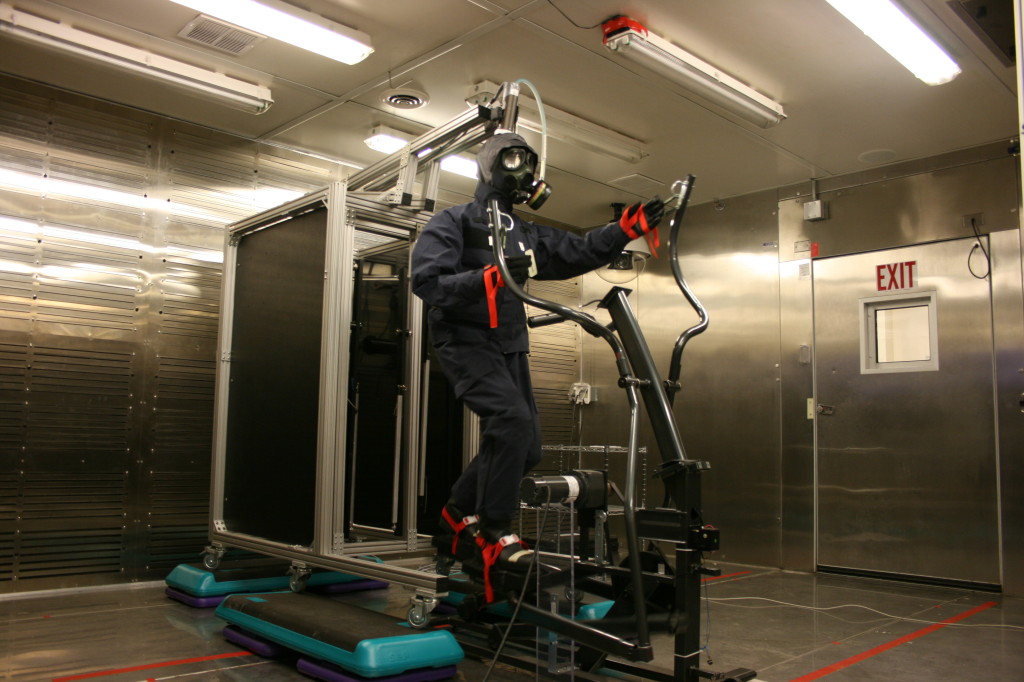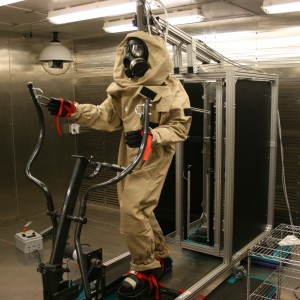NCSU lab rethinks chemical/biological hazard protection testing and derives important new conclusions.

When you ask first responders if they are more concerned about having enough protection against flash fire exposures, ballistic and physical hazards, heat stress, or chemical and biological threats, more times than not they are going to say they are most concerned about the chemical and biological threats. It is human nature to be apprehensive toward things that are not well understood or identified.
When they see a car or house on fire, most people can immediately identify the hazard and what the fire can do to them. The same goes for gunfire or other physical weapons that can result in stabbing or blunt force trauma. These are all common threats that people can relate to and realize that every time they come in contact with them, the hazard is the same and the result will be similar. Fire is fire, bullets are bullets, and knives are knives.
Overcoming misconceptions
Chemical and biological threats are completely different depending on the actual compound or agent that is present. The majority of the time, all that the first responder may see is a puddle of liquid that may be as innocuous as water, as corrosive as concentrated acid, or as deadly as organophosphate nerve agents. Since the identification of the chemical and the hazards associated with it are not possible by sight alone, first responders need to have the most protection from the widest array of chemical and biological threats as possible.
With all protective clothing, the ideal for the manufacturers and first responders would be one material and one suit that provides protection against all threats. In reality this ideal suit does not exist and may not actually be required. Instead, the design, manufacture, testing, evaluation, and certification of chemical and biological protective clothing is focused on the idea of providing appropriate protection from possible threats balanced with minimal thermal burden for specific end uses.
In the field of chemical and biological protective clothing, a common misconception is that the most impermeable or impenetrable materials will automatically provide the highest level of protection against toxic industrial chemicals (TICs), chemical warfare agents (CWAs), or biological hazards. In actuality, even the most impermeable material can fail to deliver the desired protection if the seams, seals, closures, and other interface areas are not optimized to provide the same level of protection as the material itself. In other words, if a material cannot be sealed around the respirator, if the seams are not gas tight, or if there is nothing connecting the gloves or boots to the garment, it will provide much less protection than the material of which it is constructed. This fact drives the necessity to perform full ensemble evaluations in addition to the standard material-level chemical permeation resistance testing.
The MIST method

The American Society for Testing and Materials (ASTM) International provides test methodologies for evaluation of numerous material and garment characteristics and properties. The National Fire Protection Association (NFPA) provides the performance criteria that the protective ensembles must meet to be certified for the specific end uses. Included as a test method in the NFPA and ASTM standards is one of the only full ensemble evaluation methods that is currently used to evaluate and certify chemical protective ensembles.
The Man-In-Simulant-Test (MIST) provides an evaluation of the how the ensemble performs as it would be used in the field. The test requires that human subjects don the chemical protective suit along with the gloves, boots, respirator/SCBA, and any other component that would normally be worn as part of the ensemble. The subjects are then placed in the MIST chamber at a controlled temperature, humidity, wind speed, and warfare agent simulant concentration. Instead of exposing the subjects to hazardous sulfur mustard or nerve agent, the chamber is filled with the relatively non-toxic methyl salicylate, commonly known as the oil of wintergreen, which serves as a simulant for the test.
Prior to entering the chamber, the subjects have thirty passive adsorbent dosimeters (PADs), which are simple air samplers, placed on their body in areas that represent different skin sensitivities as well as common places for interfaces in the garment. For example, there are multiple PADs around the head and neck since this area is very sensitive to absorption of chemicals and most ensembles have a respirator-garment interface in this area.
During the test, the human subjects perform a number of various exercises and job related tasks, such as a dummy drag, ladder climb, and crawling in place. These tasks are designed to stress the interfaces of the ensemble so that the protection level can be evaluated in a dynamic scenario as opposed to a static material-level permeation test. The PADs adsorb any of the simulant that infiltrates the suit through poor closures or inappropriate zippers or seams.
Following the test, the amount of simulant on each PAD is measured and related to a dosage inside the ensemble at that particular body region, and finally a protection factor is calculated by creating a ratio of the dosage outside the suit to the dosage inside the suit.
Making MIST work
Even though the standard committees and organizations have been working to improve many of the test methods for years, the MIST methodologies were mainly ignored because there were very few places that even conducted the test and even fewer that had the ability to conduct research on the test method. In 2008, the MIST facility at North Carolina State University’s Textile Protection and Comfort Center (TPACC) became the only facility of its kind at an academic institution in the United States. This facility made it possible for the industry, academia, and government to have unprecedented access to conduct testing and evaluation and well as research on the method itself. Since its inception in the early 1990s, the MIST had developed a reputation for being too difficult to conduct, too time consuming, and too variable. With the new facility, the research team at TPACC was able to address each of these complaints about the test method, many of which stemmed from a lack of understanding of why the test was originally developed and how it was originally intended to be conducted.
The most important misconception about the test that was addressed by the research was the source and meaning of the variability. Most people associated the variability in the test results with the use of human subjects because each person has different physiology, body size, and body shape which can all affect how a suit fits on any given day. Through testing one ensemble three times on eight human subjects for a total of 24 replicates, and then comparing those data to the same ensemble on an articulated sweating manikin which did not change from test to test, the research team determined that the variability has nothing to do with the person inside the ensemble. The three replicates on the manikin and the three replicates for each of the eight human subjects produced the same level of variability.
This first experiment used an NFPA 1994 Class 3 ensemble which is designed to provide a lower level of protection, and therefore a lesser degree of thermal burden for the user. A second experiment, carried out with the same human subjects, was conducted on a NFPA 1994 Class 2 ensemble, which is intended to be more protective. The Class 2 ensemble was a one-piece suit with one interface around the neck and one interface around the respirator. In contrast, the Class 3 ensemble was a two-piece suit with a zipper around the waist, the gloves and booties were not connected to the ensemble, and a zipper that went straight up the neck and around the side of the respirator. The results from the MIST evaluations showed that the level of the protective ensemble and therefore the design drastically affected the variability associated with the resulting protection factors across the body. The Class 2 ensemble resulted in much less variability compared to the Class 3 ensemble. Again, this experiment showed that the variability associated with the MIST results had nothing to do with the subjects inside the ensemble and everything to do with the design of the suit itself.
Basically, the variability indicates where the weaknesses are in the suit design. A closure mechanism that works well and can be sealed exactly the same way every time the suit is donned (e.g. the gloves being connected to the suit sleeve) will result in high protection factors and very low variability. On the other hand, a closure mechanism that works well when it can be sealed correctly but performs poorly when not sealed correctly (e.g. the zipper around the neck and respirator on the Class 3 ensemble) will result in lower protection factors with very high variability from subject to subject.
This research into the actual methodology and meaning of the MIST results has allowed manufacturers to further evaluate and understand the weaknesses in their garment designs. What was originally thought to be a downside of the test was shown through research to be an extremely beneficial aspect of a test that, for once, did exactly what it was designed to do. Only through conducting the test in the appropriate manner and understanding the data was this concept realized.
 TEXTILES.ORG
TEXTILES.ORG


